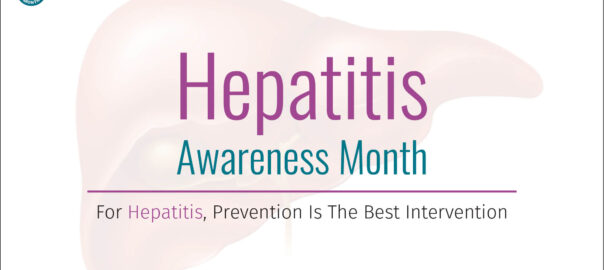“For Hepatitis, Prevention is the Best Intervention”
The month of May is titled as “Hepatitis Awareness Month”, as a proactive step to bring together various federal, non-federal, social groups, and public health care groups across the world for spreading awareness about hepatitis infection. As described by the World Health Organization (WHO), hepatitis is an inflammation of the liver caused by drugs, alcohol use, or certain medical conditions. But in most cases, it is caused by a virus. This is known as viral hepatitis. Currently, there are 5 main hepatitis viruses, referred to as types A, B, C, D and E, but the most common forms are hepatitis A, B, and C. Hepatitis is a global concern as it leads to more than1.4 million deaths every year. Hepatitis is a relatively silent disease in its acute phase, its symptoms often go unnoticed till the disease is progressed to a chronic and often a fatal stage. In its advanced stage, hepatitis can result in fatal complications like liver cirrhosis, liver cancer, or liver failure. Bridging the knowledge gap about hepatitis (its causes, symptoms, and prevention) among the masses as well as healthcare professionals is the key to reduce the global burden of the disease.
Hepatitis awareness month is an initiative to bring in all stakeholders of the healthcare industry to alliance together in spreading awareness about hepatitis. Enabling the people to identifyviral hepatitis as a critical health concern and providing better healthcare facilities to all the patients with hepatitis are the prime objectives of this collation. The key strategies that are promoted for spreading the awareness are:
- Campaigns: As an age-old method of spreading awareness, campaigning about hepatitis is a dynamic tool in spreading the word.Patient stories, supporting videos, fact sheets, posters, templates, infographics, customizable flyers, infographics, promotional badges and bands, on the spot quizzes, and street plays are few modalities that could be used for campaigning at institutional and community levels.
- Digital tools: Using digital media like television, radio,ormobile messagesfor sharing informationabout hepatitis, its risk factors, and vaccines.
- Social Media: Various social media platforms are used to share information about various campaigns, resources, publications, news updates, and latest updates on hepatitis. This acts as an open platform for masses and healthcare professionals to share knowledge and experience about the disease. Any user can easily join the conversation by using hashtags #HepAware, #HepTestingDay, and #hepatitis.
- Proclamations: Atinstitutional and community level,several proclamations related to hepatitis such as hepatitis awareness day, hepatitis awareness week, or hepatitis screening day can be initiated to generate awareness among people at the specific level.
- Free hepatitis risk assessments and testing: Various healthcare institutions, public health care centres, community health groups, and private hospitals run a day/week long free hepatitis risk assessment and testing camps. The sole idea of these camps is to enable the masses to identify the risk factors for hepatitis infection and prevention strategies for the same.Self-assessment forms and professional diagnostic checks are the components for this risk assessment and testing programs.
Viral hepatitis is a preventable disease. Effective and timely vaccination among the high-risk group and all infants is highly recommended by healthcare professionals. Providing cheap vaccination and encouraging people to get vaccinated are crux steps in halting the endemic of hepatitis across the globe.
As said earlier, prevention is the best treatment; the statement holds true for hepatitis. The best way to combat this lethal disease is to make people aware about how it spreads, what are the early signs, what can be done to prevent it, and what should be done if one gets hepatitis. As a member of healthcare industry, we all should actively take up the responsibility to spread awareness about hepatitis in our own way. Remember to be informed is to be safe!
Awareness is the first step towards prevention of viral hepatitis. As a part of their Corporate Social Responsibility (CSR) activity,Turacoz Healthcare Solutions wants to raise awareness for prevention of this disease through this blog. We are a medical communication company in Delhi. Our medical writers are well-versed with recent advances in various therapeutic areas which give them a head start in various publication, clinical research and regulatory writing projects.


